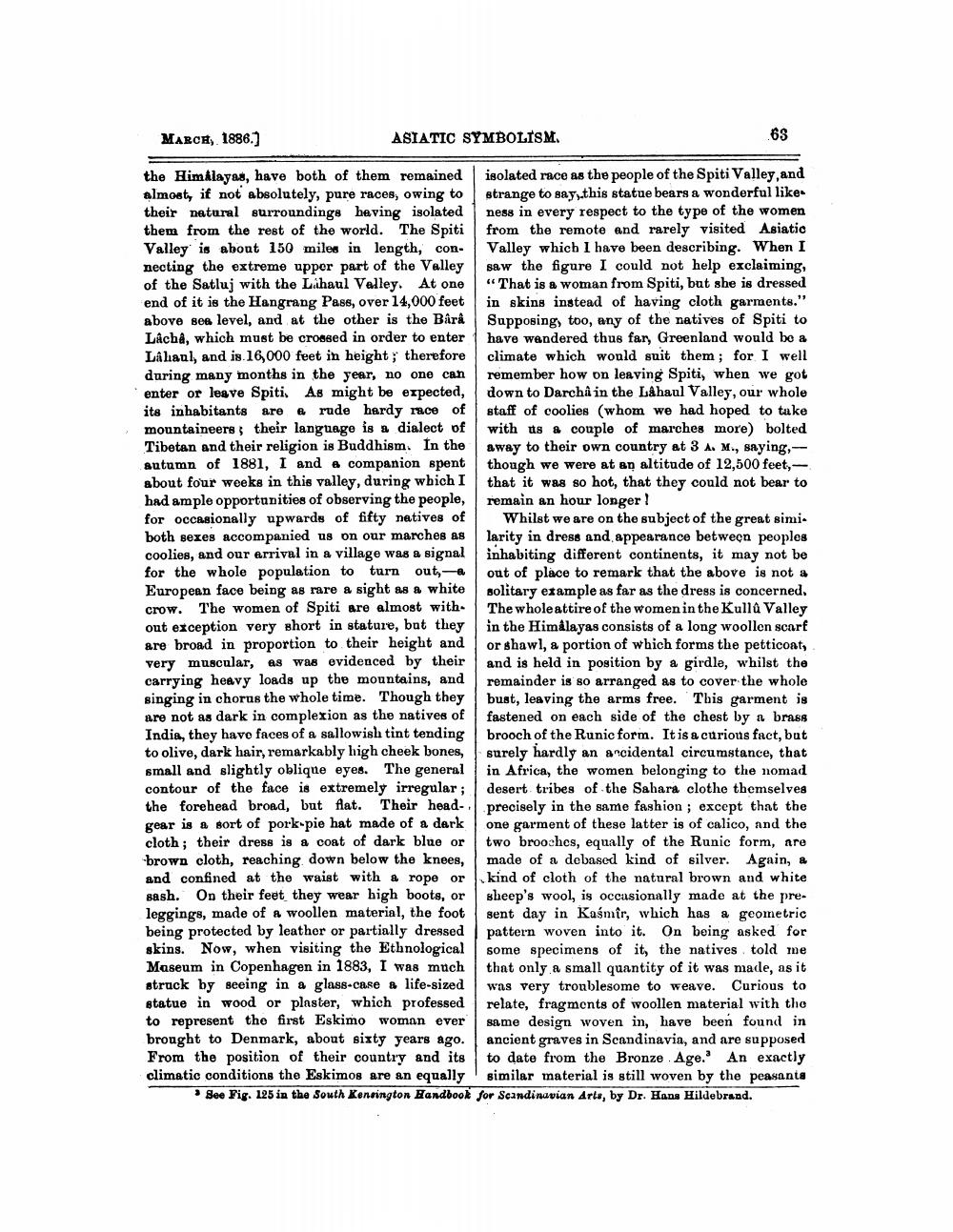________________
MARC#, 1886.)
ASIATIC SYMBOLISM.
.63
the Himalayas, have both of them remained isolated race as the people of the Spiti Valley, and almost, if not absolutely, pure races, owing to strange to say, this statue bears a wonderful liketheir natural surroundings beving isolatedness in every respect to the type of the women them from the rest of the world. The Spiti from the remote and rarely visited Asiatic Valley is about 150 miles in length, con- Valley which I have been describing. When I necting the extreme upper part of the Valley saw the figure I could not help exclaiming, of the Satluj with the Lihaul Valley. At one "That is a woman from Spiti, but she is dressed end of it is the Hangrang Pass, over 14,000 feet in skins instead of having cloth garments." above sea level, and at the other is the Bârå Supposing, too, any of the natives of Spiti to Lácha, which must be crossed in order to enter have wandered thus far, Greenland would be a Láhaul, and is. 16,000 feet in height; therefore climate which would suit them; for I well during many months in the year, no one can remember how on leaving Spiti, when we got enter or leave Spiti. As might be expected, down to Darchâ in the Lahaul Valley, our whole its inhabitants are a rude hardy race of staff of coolies (whom we had hoped to take mountaineers, their language is a dialect of with us a couple of marches more) bolted
Tibetan and their religion is Buddhism. In the away to their own country at 3 A. M., saying, autumn of 1881, I and a companion spent though we were at an altitude of 12,500 feet, about four weeks in this valley, during which I that it was so hot, that they could not bear to had ample opportunities of observing the people, remain an hour longer! for occasionally upwards of fifty natives of Whilst we are on the subject of the great simi. both sexes accompanied us on our marches as larity in dress and appearance between peoples coolies, and our arrival in a village was a signal inhabiting different continents, it may not be for the whole population to turn out, out of place to remark that the above is not a European face being as rare a sight as a white Bolitary example as far as the dress is concerned, crow. The women of Spiti are almost with The whole attire of the women in the Kulla Valley out exception very short in stature, but they in the Himalayas consists of a long woollen scarf are broad in proportion to their height and or shawl, a portion of which forms the petticoat, very muscular, as was evidenced by their and is held in position by a girdle, whilst the carrying heavy loads up the mountains, and remainder is so arranged as to cover the whole singing in chorus the whole time. Though they bust, leaving the arms free. This garment is are not as dark in complexion as the natives of fastened on each side of the chest by a brass India, they have faces of a sallowish tint tending brooch of the Runic form. It is a curious fact, but to olive, dark hair, remarkably high cheek bones, surely hardly an ancidental circumstance, that small and slightly oblique eyes. The general in Africa, the women belonging to the nomad contour of the face is extremely irregular; desert tribes of the Sahara clothe themselves the forehead broad, but flat. Their head- precisely in the same fashion ; except that the gear is a sort of pork-pie hat made of a dark one garment of these latter is of calico, and the cloth; their dress is a coat of dark blue or two brooches, equally of the Runic form, are brown cloth, reaching down below the knees, made of a debased kind of silver. Again, a and confined at the waist with a rope or kind of cloth of the natural brown and white sash. On their feet they wear high boots, or sheep's wool, is occasionally made at the preleggings, made of a woollen material, the foot sent day in Kasmir, which has a geometric being protected by leather or partially dressed pattern woven into it. On being asked for skins. Now, when visiting the Ethnological some specimens of it, the natives told me Maseum in Copenhagen in 1883, I was much that only a small quantity of it was made, as it struck by seeing in a glass-case a life-sized was very troublesome to weave. Curious to statue in wood or plaster, which professed relate, fragments of woollen material with tho to represent the first Eskimo woman ever same design woven in, have been found in brought to Denmark, about sixty years ago. ancient graves in Scandinavia, and are supposed From the position of their country and its to date from the Bronze Age. An exactly climatic conditions the Eskimos are an equally similar material is still woven by the peasanta
See Fig. 125 in the South Kensington Handbook for Scandinavian Arts, by Dr. Hans Hildebrand.




